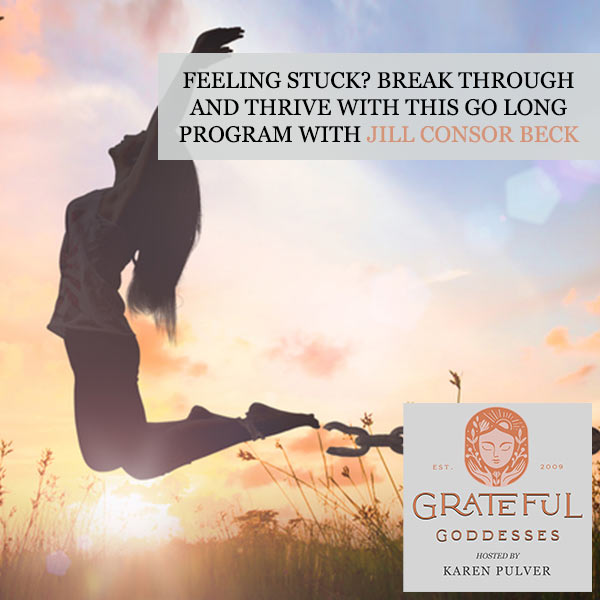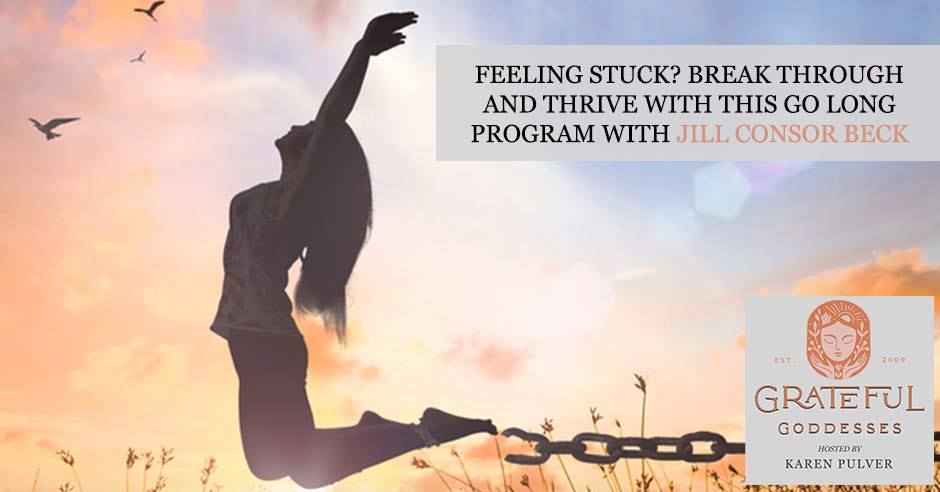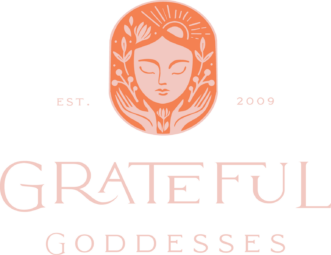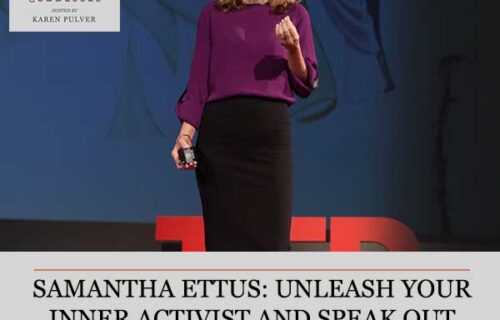
Jill Consor Beck: Feeling Stuck? Break Through And Thrive With This Go Long Program

In this episode of Grateful Goddesses, we dive deep into the “Go Long” program with Jill Consor Beck, a transformative approach to living a better, longer life. Jill’s philosophy is simple yet profound: it’s never too late to make meaningful changes. She teaches that by subtracting the non-essential moments in our lives, we can create space for what truly matters.
Jill’s program stands out for three key reasons: empathy for the struggle, pragmatic steps, and an unwavering optimism. She shares her unique approach to helping clients break down big goals into manageable steps, ensuring sustainable progress without overwhelming pressure. Jill also emphasizes the importance of “down time” — a concept that’s often overlooked but essential for setting up a successful tomorrow.
From practical advice on improving sleep habits to creating systems that foster accountability, Jill offers tools and strategies to take charge of your life. She encourages us to evaluate our parents’ lifestyles as a mirror for our own future choices — highlighting the importance of health and vitality in our later years, no matter our financial status.
In our conversation, Jill shares her top tips for 2025, including:
- What one habit can you cultivate by 2026?
- What can you subtract from your life to make room for something more meaningful?
How will you hold yourself accountable?
Jill’s insights are down-to-earth, actionable, and inspiring. She even helped me personally with a trial session, where we tackled a long-overdue task, and the results were life-changing! Listen to the last 10 minutes of the episode for our favorite “cool” items — it turns out, Jill and I are on the same wavelength when it comes to the things that light us up!
If you’re feeling stuck or in need of a nudge to get things done, Jill’s Go Long program might be just what you need to break through and live a more fulfilling life. Tune in for an inspiring conversation about making life-changing shifts and living with purpose!
UPDATE: Since the recording of this episode, Jill has continued to support, guide, and encourage me with this goal. I recently passed the Adler School of Psychology and Coaching exam with flying colors. I am so grateful for Jill’s help!
—
Watch the episode here
Listen to the podcast here
Jill Consor Beck: Feeling Stuck? Break Through And Thrive With This Go Long Program
It’s New Year 2025. I know you’re thinking, “I’m going to make some resolutions.” Resolutions do not work. The gym is probably so crowded. You’re probably making your green smoothies as we speak. Let me tell you, the idea that you’re even thinking about a resolution is good, but the resolution itself is not. We’re going to talk a little bit about that. Many of us have challenges that happen in our lifetime. We all have different things that pop up that stop us. It may even block us from doing what we want to do.
Our guest is going to be that person who can help you get past that. She’s helped me. I went through her program, and it was empowering and so helpful. I want to tell you a little bit more about that. Let me first explain a little bit about her. Her name is Jill Consor Beck. She is the Founder of Go Long. Go Long is her program where she will text you to continue doing what you may have decided you’d like to do but are having trouble doing. She worked in the investment banking firm as well as tech companies until she decided, “I want to help women push forward and nudge them to do those things they want to do.” Welcome, Jill, to the show.
It’s wonderful to be here. Thank you, Karen.
I met Jill on Lindsay Pinchuk’s Marketing Made Simple. There’s a little plug for Lindsay. I stumbled across her on Instagram. I met Jill in one of the cohorts. We were chatting about our businesses and different things back and forth. I loved the word Go Long. Can you explain a little bit more about that?
The Concept Of “Go Long” And Living Better, Not Just Longer
A lot of people think Go Long means American football. We’re in the midst of the NFL season. Go Long is about your life, not just living longer but living better as you’re living longer. There are all these statistics in the US that we’re living longer than we’ve ever lived, but the quality of life we have isn’t as good. We need to try and match those up a little bit. If you’re still rocking it in your 70s and 80s, we want you to be having the best life you can. That starts with making these decisions in your 40s and 50s, which will lay the groundwork for being able to go long and live your best life.
As with the foundation of a house, make sure it’s sturdy and strong.
A lot of times, people turn 50 and say, “I’ve never worked out. It’s probably too late.” Here’s the thing. It is never too late to make those changes. My dad didn’t work out for decades. When he turned 68, he had a bunch of things happen to him and his family, including his sister. He was like, “I’m ready to make a change.” We got him into CrossFit. It was hard. It was scalable and a little crazy.
The point is that we set him up with a program and a coach who brought him along very safely. We also tried to reframe the discussion, not around losing weight but moving more. He dropped multiple pant sizes. His endurance for doing stairs in his house changed within three months of just doing it. It’s not too late ever to begin making changes in your life.

Not just physically. I have so much to talk to you about. I don’t know where to start. One of the things you helped me do, which was key, was to get organized. I feel like it’s having a system, having organization, knowing what it is, and narrowing it down to what you want to work on. What is that key thing you have dreamt about? It could be working out, getting healthy, or taking an exam, which I’ve been putting off for so long. You helped me with that. Can you tell a little bit about how you help people with their systems, your texting protocol, and all of that?
The Pie Chart Exercise: Time Management and Prioritizing Goals
A lot of people have misconceptions. You talked about resolutions at the top of the call. The one thing people miss when setting a resolution is that they haven’t thought about what they’re going to take out of their lives to make room for the resolution. A lot of what we talked about over text, because we didn’t do any of this over the phone, was little bits every day. We talked about what you want to take out. I asked you to do a pie chart of your life. What do you want your pie chart to be a year from now? How do you want your time allocated?
It’s a very simple exercise. If you’re spending X percent doing some activity that isn’t serving you, maybe it’s time to reevaluate getting it out of your life. That way, you can make room, in your case, to figure out if you could take the exam you wanted and where you had time to study for the exam. The first step is helping you look at your calendar, how you’re spending your time, and figuring out what you can take away. Your goal was, “I want to take this exam and pass it. I have to put myself in a position to do this.”
I’ll never forget when you texted and said, “Where are you sleeping? Where’s your downtime?” I was like, “My downtime is listening to a podcast or book while folding laundry.” You were like, “No, that’s not downtime.” Everyone needs sleep. You need to factor in sleep and downtime in a pie chart. That’s key, so you can look at it. Maybe remove the Netflix shows you watch for three hours. That’s one of my vices, especially when an episode ends and the next one starts.
Shut it off. Go study. It’s important to write it down. On this show, we talk a lot about visualization and manifestation, the Law of Attraction, but it’s important to write something down. Not just to focus on what you have to do but also because it could start attracting good things to you. Do you believe in that at all? Does that factor into your program?
We did that with you. You wrote the pie chart, looking at how you’re spending your time. Put in those cues when you’re sitting there saying, “My downtime is when I’m listening to the podcast and doing laundry.” It’s a combination of those things. Once you hear that, you visualize, “Wait a minute. That needs to be another thing on the pie chart that I need to add in there.”
Looking at the future pie chart, that’s where you’re manifesting, “My goal is to be able to allocate X percent of my hours per week to this activity.” In your case, the first quarter was about studying. Ideally, when you pass the exam, not if but when, it’s going to be about building your coaching business. Looking at that future pie chart helps manifest that.
It doesn’t need to be a pie chart. It could be whatever it is. Some people love pictures. The pie chart is a powerful tool. Some people want to list it out. That’s the beauty of Go Long. I will figure out whatever cue is going to help you stay focused. I’m also a big believer in the idea that you can’t hit what you can’t see. It sounds like you are, too, with writing things down. Instead of having it be this big, hairy, scary monster in your head, get it on paper.
You can't hit what you can't see. Share on XThe beauty of what we did was that you had so much to figure out. There were a lot of unknowns associated with you taking the exam and a bunch of other things that we don’t need to get into. It was around, like, “Let’s break down everything you need to find out for you to sit for the exam.” That was the first thing that we did. We broke down all of the individual things. Every day, try and do one of those many steps to get you to the point where you are able to find out. We did this in just over a week. You were able to hit a major milestone, which is your eligibility for sitting for the exam.
Accountability And Overcoming Procrastination
I found it much less scary when you helped guide me through that. I’m a coach. This exam is for my accreditation. It’s my final step. I was scared of this exam, also because when you put something off for so long, life gets in the way. I don’t mind sharing with my audience because that’s the whole point of what I do as a coach. I talk to people about how to bounce back and get that resiliency.
What’s important for the show, too, is having that support and accountability. You gave me that accountability. It was like this little nudge. I’d look at my phone, and you’d pop up. It wasn’t just like, “Did you get this done?” My mom can do that. She does. I can do that to my kids. It was like, “Focus in on X, Y, and Z. Do ABC first.” That made it so much easier, Jill. Once I went over that hurdle, it was another one and then another one.
I’m signed up and ready. I just have to study. I can do that. I had a lot of stuff with another job that I was working at full-time, helping out the family with my health issues that were paralyzing me a little bit. I had to put myself on hold. You helped empower and inspire me to say, “You don’t have to put yourself on hold. You’re thinking this grand big thing that you have to do for yourself.” It seemed so overwhelming, but you broke it down and sent me those very clear, detailed text messages that were helpful. Thank you.
I was happy to do it.
I like to try out people’s programs. Trust me. I’ll tell someone, “There’s a glitch here. I don’t think this works. Maybe you want to improve that.” I believe in constructive criticism. Every single step of what you did was helpful. I think I’ll pass, but if I don’t, it’s okay. We talked about that, too. I can always retake it. The fact that I’m going to be doing it is a huge weight lifted off my shoulders. I no longer have nightmares.
Honestly, I would have those, like going into the exam naked nightmares or being back in high school nightmares. That was because it was in the back of my head. Now, it’s organized and planned. I want to take a few minutes to talk about you and your story. You were doing something completely different until you switched over. Tell us about that.
I’m originally from New York. I live in Seattle. I worked in investment banking for ten years. I migrated into tech when I moved to Seattle. I built technology products that we use every day, like what we’re using with Zoom. A lot of building technology products are around triangulating disparate sources of data on the fly, as well as being able to break things down into manageable components.
When Zoom started, they had a vision of what they were trying to build, but as they were building features, they didn’t think about all the things. When the teams were building the features, they were focused on one specific scenario and envisioning what if people want to record conference calls. You break it down into tasks in terms of what things you need to put in place so that people can record a call like what we’re doing.
I got sick and tired of the misogyny associated with my career, both in finance and tech. I also have three autoimmune diseases. I was diagnosed with my first autoimmune disease back in 1996 or ’97. I’ve learned a thing or two about how to manage your health because I didn’t always take care of myself, particularly when I was in investment banking. I’ve made all the mistakes.
I know all of the pitfalls that people can fall into, like the New Year’s resolution pitfalls, and helping people short-circuit that so they can hit their intended goal in a way that makes it more sustainable, so they’re not dropping their New Year’s resolution by January 18th, which is the day that most New Year’s resolutions die. I focus on how to help people be accountable, which I used to do in my previous role, but also leveraging those skills of pulling in different sources of data.
When you’re telling me, “I’m working all the time with this,” but I also know that you’re still in your recovery from your stroke and thinking about what’s going to be the right language that’s going to resonate with you so that this way you’re going to feel emboldened and empowered and not like a shrinking violin, thinking, “I feel like a failure to my coach.”
That’s the last thing that I want you to feel. It’s triangulating different things like that and different cues you have going on where you’re not just working in this full-time job. This is a family business, which also helps bring income to your family. It’s not as simple as working 40 hours a week and calling it a day. It’s having that understanding of your relationship.
I had some individuals I spoke to. Not to put down therapy or anything, but the message was, “Stop working there.” I was like, “No. You can’t just stop.” “Get over it. You look good. You’re fine.” I’m like, “No, I’m exhausted. I have to take into account my physical health, my kids, and my life. I did appreciate that.
Empathy, Pragmatism, And Optimism in Coaching
A lot of what goes along is I use three words in terms of my practice. That is empathy for the struggle. My husband had major brain surgery. He’s fine now, knock wood. The thing is, I know things don’t connect the same way they used to. It’s having that understanding of saying something and being like, “I wish I could do that, but my brain does not work like that anymore. Thanks.”
Pragmatism. That’s where it goes back to this particular situation with you where it’s sitting there and being like, “Cut back your hours.” This isn’t a standard job that you’re doing. You’re helping in the family business. Being able to have ways to have those conversations in a candid way that doesn’t trash your relationship with your husband is important, and understanding that.
The third thing, which is important and where that manifestation comes in, is optimism. Empathy, pragmatism, and optimism. Once you started getting things off your initial to-do list, you started getting excited and feeling less defeated. I could tell in your text that you were like, “I did this. I got an answer. It wasn’t the answer I wanted, but I got an answer. At least I’m empowered to move forward, even though I didn’t get the answer I wanted.”
One of the things we talked about is that it doesn’t serve you well when you don’t have an answer and you’re scared to get the answer, which is very common for a lot of people. Knowledge is power. Even if you don’t get the answer you want, as long as you have an answer, you can make a decision. Is this something you want to continue to pursue or something you want to put off and restart at a later date?
Knowledge is power. Even if you don't get the answer you want, having an answer allows you to make a decision. Share on XA lot of people think they need to wait. It’s Sunday when we’re recording this. It’s a perfect example. Most people, particularly women over 40, are thinking, “I need a Sunday afternoon. We’ll have 3 or 4 hours to focus on this.” One of my clients came to me. She was trying to get her divorce agreement done. She put it off for three months.
We got the bulk of it done in eight days in a similar way that I did it with you, where we broke it down into something where she only had to spend half an hour every day. That was it. We time-boxed it and said half an hour tops. She got more confident as she continued to make progress on it, which is exactly what happened with you.
I felt that.
I felt it through your text where all of a sudden, you were feeling like, “I’m so exhausted.” You had a lot going on. The other thing that I try to provide clients is giving them a different perspective on where they may be able to have more flexibility than they didn’t think they had. I’m on the outside looking in. I’m sitting there saying, “Karen, maybe there’s a way, in terms of the hours that you’re working, that you can do something before work that you wouldn’t normally do.”
We talked about subtracting something before you’re adding something, which is one of your philosophies or takeaways, which I never thought about because we’re always adding. It’s like, “What is not helping us? What can you take away to fill with something that will serve you?”
The biggest challenge I have with clients is that once we help free them of something, they immediately rush to put something else back in. It’s okay to have downtime and be bored. You talked about Netflix and everything. Here’s the thing. Say watching whatever guilty pleasure you have on Netflix is what helps bring your stress level down. I’m watching Unbreakable Kimmy Schmidt. It’s a total goofball show. It’s mindless, but it helps bring me down at the end of the day to a point where I can get a good night’s sleep. The key is finding out how much time you want to allocate to that so you can get sleep and you’re not binge-watching until 1:00 in the morning.
Excessive after a while.
With my husband and I, fortunately, he’s not a binge-watcher, so we pretty much time-box. “How long are we going to watch Netflix or Apple TV?” We’ll watch for an hour. We’ll watch something that we’re like, “This is cool. It’s time to go to bed.” I’m guessing a lot of your demographic is women over 40. The most underrated part of your day is your wind-down routine. Your wind-down routine is what is going to table-set your next day.

You could have woken up and had all these plans to do all of these things, and then life gets in the way. Your mom. You’re worried about your parents, in-laws, and the family business. You’re studying. You name it. You’re worried about all the things and trying to get a workout in. You take that very seriously. You didn’t get done what you wanted to get done. This is very common.
Your wind-down routine is the best way for you to reset and make sure that when you take enough time to bring your stress level down from 80% to 10% before you go to bed, and that doesn’t happen in 10 minutes, you’re putting yourself in a position to get a good night’s sleep. When you put yourself in a position to get a good night’s sleep, that sets you up in terms of being able to make better decisions around your food, work, and family. You have a better workout and all of these things.
It’s the night before, when you are taking the time to do the wind-down routine. The metaphor I like to use is of a car. It’s not good for your car if you’re going 70 or 80 miles an hour and slamming on the brakes to go to 10 miles an hour. That’s not good if that’s something you constantly do. That’s what a lot of us do. You’re on your phone, and you’re like, “I’m doing this. I’m doom-scrolling.” Then it’s like, “I’m going to brush my teeth, wash my face, and go to bed.” That doesn’t work. The thing is figuring out how you could gradually bring your stress level down a few pips.
Sleep Hygiene And Preparing For The Next Day
It’s sleep hygiene. That’s how I look at it. I’m guilty of scrolling. My husband and I scroll. I have started putting my phone in the bathroom, charging it there, and my glasses. I need to read, so I put my glasses away. Those little things prevent me from automatically turning over and scrolling on my phone. There’s also a setting where I allow my young adult children, if they need to call me, that their calls and texts will go through. It’s the worry about that, specifically. If I shut my phone off, I can’t get those emergency calls. God forbid.
You can still set things in place. I love that about setting up for the next day. I often put my workout clothes down in a pile so that I just put them on in the morning. You sign up for those classes. If you can’t, I’ll just go out for a walk. It’s also about not beating yourself up at the end of the day if you can’t do whatever it is you planned on doing. Your body or your mind may have needed that rest on that day. You can recharge and start up again in the future.
A lot of people beat themselves up, like, “I’m supposed to go to the gym three days a week. I suck because I don’t have the discipline.” They sit there and have a lot of negative self-talk. They’re like, “I’m terrible. I have no discipline to not eat whatever food I want to eat. I’m always up for a good burger and fries. That’s my thing.” The thing is that people look at this the wrong way when they’re thinking about a lack of discipline. It’s not that. It’s more of a lack of taking time out of your schedule and figuring out what you can remove so that you can make the time. A lot of times, people come to me and say, “I want to lose weight.” It’s not about losing weight. It’s about thinking more about how you want to move.
When we’re talking about Go Long, since you asked the question earlier, how do you want to move when you’re in your 70s and 80s? A lot of times, I try to get people to talk to me about their parents, which could be a triggering conversation. I’m not trying to be mean or anything like that, but it’s very thought-provoking because they’re like, “My parents have money to travel,” and they can’t travel because of health issues. Maybe a parent passed away earlier. “My parents can’t attend my kid’s soccer games because standing on the sidelines for a long period is not a good situation for them.”
It’s getting people to envision and manifest, like, “I want to be playing with my grandkids. I want to be able to get on the floor and play dolls with them or do whatever and have fun. I want them to look at me as someone who wasn’t just sitting on the couch but someone who took the time to do things with my grandchildren.” That’s where that fundamental work, as you called it, building the house, matters and becomes a thing.
I look at my daughters. I remember myself back then thinking I was invincible in every single way. I could eat and drink whatever. My body was going to take it. I was going to continue. It’s like sunscreen. I tell my girls about sunscreen and all of these things. When you hit your 40s, you’re looking back and thinking, “I wish I had put the eye cream on.”
It is important to prepare yourself. As you would for your kids, you get their lunchbox ready the night before. You carve out time to organize and have these systems in place. In your last email to everyone, which I loved, you mentioned making your goals fit your life, not someone else’s Instagram and/or Facebook. Lindsay Pinchuk talked about comparison being the worst enemy.
The phrase that I’ve heard is comparison is the thief of joy.
We all do it. You did say something about not being a Karen, but I understand. That’s okay. It’s funny because I posted about my year. I had all these pictures. I did a reel. I felt the need to write. These are happy moments. We all have negative times, but why focus on them? When you’re looking at someone else’s beautiful photos and life, we all go through shit and hard times. It’s good to focus on the positive. Keep that in mind when you’re scrolling.
I see that a lot with social media influencers. I was off of social media for seven years and got back on when I started Go Long. That’s where this demographic is. Everyone’s on social media. I hate social media, but I have to use it. The reason why I hate it is because it’s not real life. When you’re looking at influencers who have this beautiful body, at least in terms of society’s standards, you have no idea what contortions they have to make to make themselves look like that.
They could be telling you, “I sleep 9 hours a day. I drink water and eat all this.” You have no idea what’s going on behind the scenes. A lot of times, those people who have those beautiful bodies are also not living their lives. Their life are about making sure that they look a certain way on social media. Life is about those moments with the people we care about and laughing. We’re a very New York family. My husband’s from a much more introverted family. My family is your typical New York Jewish family.
Life is about moments spent with the people we care about and the laughter we share. Share on XThere’s constant banter back and forth over whether we’re having some potato chips, ice cream, or whatever it is. It’s fun. I would tell people, “Live your life.” When it’s all said and done, at the end of your life, is it going to be like, “I stayed ripped until I was 80,” or is it more of like, “I was able to travel and experience things with my grandkids and my kids, for as long as possible, and we have these memories?” It’s more about not focusing on these influencers who are sitting there saying that you can lose X amount of pounds in 12 weeks, which most likely you’ll gain back after the 12 weeks. Focus on how you want to live your life. What are the things that matter to you? That is what going long is all about.
It’s how you want to feel. It’s not about focusing on perfection. I’ve not met you personally, but I felt this authenticity from you because you present yourself as you are and talk about your struggles. I do that, too, on the show. How are we going to help each other? How are we going to empower each other if we don’t talk about those? Not to dwell on them because you can, but how are you working through them? How are you envisioning your future? How are you preparing yourself to go long?
I love it. I’m so grateful that I met you. I want to end with this. You talked about accountability. That’s key because that helps with a sustainable plan. You can make all these plans and do all that, but how are you going to hold yourself accountable? I loved our week of texts, but the next day, you said, “This is my last one.” I wanted that little nudge the next day, but you did empower me to do this on my own. In helping women or individuals, how do you help them remain accountable for the goals or the different challenges they want to get through?
Accountability And Building Confidence Through Coaching
With you, we did a trial. I work with clients for a minimum of three months. You could sign up for six months. Once you tackle one thing, there’s always something else to be tackled, like the person with the divorce agreement. There were other things they wanted to tackle as well. It’s a matter of finding out. Once they build some confidence, this new aperture opens up for them, and a wider world becomes available.
They’re like, “I don’t have the weight of the world on my shoulders around this coaching certification because I got the coaching certification. I can focus on my coaching. I also don’t have that stress of the exam and everything else.” That weighs a lot on people. A lot of what I do is figure out. If we were still working together, Karen, we’d be going back to the twelve-month pie chart thing. What do we want your pie chart to look like in twelve months? How do we start putting in the fundamentals to make that happen? A lot of people want to have that twelve-month pie chart by the end of January 2025. It’s not going to happen.
That’s why we focused on your goal a year from when we started, which was in December 2024, to be coached and have a roster of clients. That’s your North Star. The first step was finding out your eligibility for the exam. It wasn’t even studying for the exam yet. It was about finding out your eligibility for the exam because it wasn’t a clear-cut black-and-white answer. It wasn’t easy to ascertain. We focused on that. I kept you focused on that instead of getting distracted.
You held my feet to the fire. You were like, “You can do this. What about this? Check this and that out.” “I didn’t even think of that.” You circled back and were like, “Did you do it? How did it go?” I was like, “I did it.” You celebrated with me.
A lot of people, when you see this on social media, it’s like, “I’m going to the gym. Who wants to be my accountability partner?” It’s great to have your friends or family members do that kind of thing, but here’s the kicker with that. You may be trying to kick a habit that no one knows about. You don’t want to tell your friends. You don’t want people to know. Me? I don’t care. I’m a subjective person. Unless you’re a serial killer and you’re like, “I want to stop killing people.”
You talked about picking the right accountability. You don’t want someone to sabotage your efforts, too. They may not want to work out, but you’re their buddy. They’re like, “Forget it.” You want someone who is going to be there.
I’m going to be objective. I had one client where it was like, “My friend and I were doing this accountability thing where we’re going to the gym, but they want me to show them how to use the equipment. I don’t have a lot of time to work out.” I’m like, “This is not serving you well. You need to have a conversation with your friend and say, ‘I don’t have a lot of time. I get that you want to work out and understand. You should hire a personal trainer to show you how to use this equipment so that we can both get our workout in.’ You should be candid with them and say, ‘I’m starting to resent this time because I’m spending the time I have to work out helping you. I’m not getting my workout in.’”
If you were to give three pieces of New Year 2025 phrases, what would they be?
It’s what we’ve talked about already. Number one is thinking about a year from now. It’s January 5th, 2025. On January 5th, 2026, what is one change that you would have liked to have made at this point and have as a habit, not as a resolution, but something ingrained in your day-to-day life? That’s that manifestation thing. That’s your big-picture thing.
Number two, I’d be thinking about what you are subtracting. What are you willing to subtract from your life to make that happen? Number three, how are you going to hold yourself accountable for making that happen? Some people are very good at holding themselves accountable. The other thing you have to remember is that there are probably things. Karen, you’re very good about going to the gym. You don’t need me to hold you accountable for going to the gym.
Even the people who are good at holding themselves accountable have things that they are not good at holding themselves accountable for. Everyone procrastinates. You have to be honest with yourself on that third step on how you’re going to hold yourself accountable. What system are you going to create that’s going to help you stay accountable? In tech, they talk about systems a lot. I’m not talking about technology systems. I’m talking about accountability processes and everything. Your system is way more impactful to hitting what you want to hit than just having the goal. If you don’t have the system, you’re going to have a goal, and it’s just going to be there.
Without a system, a goal is just a wish waiting to happen. Share on XIt’s going to be there and feel like it’s unattainable. You’re not going to get there.
Creating Effective Accountability Systems
It’s going to be a lot more subjective. There is a system where you’re sitting there. It’s great because it’s a big cue that I use with my clients. Get your workout clothes out the night before. Me texting you at 5:30 in the morning when you’re trying to start working out at 6:00 AM every morning isn’t going to help you. My goal, if you have to start working out first thing in the morning, is to get you not to think in the morning. I don’t want you thinking. I want you doing because when you think, that’s going to give you all sorts of reasons.
You get in your own way.
You’re going to get distracted. My goal in those situations, and it’s a very common one with my clients, is the text is going to come in at 7:00 at night where it’s going to say, “Karen, you have your workout clothes ready. You have your water bottle ready. Do you know what workout you’re going to be doing? Let’s say you have a Peloton. Do you have the class in your stack, ready to go?” It’s more of that.
It’s figuring out what you want a year from now and what you want to subtract. It’s about how you realistically are going to hold yourself accountable. If you are engaging with a friend or a family member, is it someone you could be candid with and also someone with whom you’re on the same page? “We’re both going to the gym. We don’t have to do every activity together. You might be in the pool swimming. I might be in the weight room. We meet at the gym at 7:00 AM and walk out around 8:00. You do your thing, I do my thing, and it’s cool.”

Otherwise, if you don’t have those three things in place, particularly that last thing where it’s clear about how you’re going to spend the hour versus how I’m going to spend the hour, it’s not going to help you. If I’m sitting there making you feel guilty because you’re not showing me how to use the weight machines, you’re not going to look forward to it.
How To Connect With Jill And Take Action On What You’ve Been Putting Off
Jill, thank you so much. If people want to reach out to you to book your services or find out more about you, how can they do that?
I’m on YouTube, Facebook, Instagram, BlueSky, and Substack. If most of your people are on Instagram, my handle is @JustGoLong. You can find me there. If you’re a YouTuber, it’s @JustGoLongVideo. There’s my website, GoLong.me. I’m pretty accessible. Whatever you’ve been putting off, I can help you. We all have things that we’re putting off. Don’t be ashamed or embarrassed. That’s also the great thing about talking to someone independent. I’m not going to judge you for putting something off. I guarantee that I’m working with someone who’s put something off longer than you’ve put something off.
Thank you. I’m grateful that we met and for your time. I’m not a football player, but go long. I’m throwing an imaginary football.
I caught it.
Thank you.
Thanks for having me.
Jill, I also want to thank you because when I signed up to write this exam for my final accreditation for my coaching business, it rolled over. It had this effect of, “I have the confidence that I can do this. I’m going to do this. What’s next?” I’m going to meet with Lindsay Pinchuk because she has this amazing program, Marketing Made Simple, which I’m already in, but I’ve been putting off doing all of these little things. I’m going to meet her, start doing my Instagrams, and start rolling over. You have that effect. Did you know that you would do that for people?
Yeah, because I have that from my experience. I get into ruts, too. For me, when I’m in a rut, I have to figure out some basic tasks that I could get done and regain some of my mojo. Once I do that, I start to take off. I found that when I was helping my friends out before I decided to do Go Long, they had their confidence come back and got themselves out of the rut. That’s something that I know I’ve experienced. That’s where that empathy comes in.
It’s true. It’s a great program. I highly recommend signing up with you.
Thank you.
‐‐‐
Welcome, everyone, to the favorite things portion with our guest, Jill Consor Beck. I brought along a favorite thing that I used. I woke up with a bit of a headache, so this is something that I use. It’s amazing. It goes in the fridge and stays cool. It’s a neoprene wrap that goes around my head. It feels so good. It’s still cool. I wear it at night before I go to bed sometimes. I’m talking with it in my head and covering my eyes, but I have to say that it feels amazing. When I get migraines, I try and take medication right away, but I don’t like to all the time. This helps. Another funny one is this mask that I put on anything cold. It feels so good.
This is the funniest thing because I just heard about these tools from two different clients. I had never heard of these things. I just heard about that pink hat.
It’s great, too. I’m going through menopause. I get hot flashes in the middle of the night. I need a little fridge beside my bed so it can stay cold. If you put it in the freezer, it stays cold longer. I’ll even put it on my body or the back of my neck because it cools you down so quickly. It’s funny you heard about it.
When you put that on your head, I’m like, “This is crazy.” It’s one of those things you’ve never heard about, and then all of a sudden, everyone talks about it.
I got this on Amazon. I’m not getting paid for this or anything. Bilitok. I love it, too. This one is Skin Gym.
Knock wood, I don’t typically get migraines, but when I do get a headache, something cold helps. Hotel rooms drive me crazy. You can have the temperature on the lowest temperature setting, and the room is still warm. Most hotel rooms have a mini fridge. Bring something like that. There are times when it’s been so hot in a hotel room. I sit there and take a washcloth. I put it under cold water.
It drips on your hair. This is good, too. I bring it on the plane. I cover my eyes and ears. It doesn’t have to be cold for that. I love it.
I’m going to get one for myself for traveling. My favorite thing that I have is, on the same vein, called a Chilipad. Let me explain what it is and why I don’t have it physically. I can send you a link. It’s a cooling mattress pad. This thing is a game changer in my marriage. The thing is that your husband can be in one setting, and you could be in another. You could set it on a timer. When you wake up, it warms you up naturally instead of beating an alarm clock. At night, it cools you down and keeps you at a certain temperature. It was not cheap. I will say that, but amortize it over you sleeping in your bed every night.
I’m taking my covers off, putting them on, and turning the thermostat down.
This thing changes all that. Guys emit heat. My husband is a human radiator on top of it. The Chilipad is a great thing. Admittedly, I do have an affiliate link with them. I want to disclose that, but I’ve been using it way before I had the affiliate link.
Does it come in different sizes?
Yeah. You can get it. It is amazing because my settings are completely different than my husband’s. If you wake up at a different time and go to bed at a different time, it’s all of those things. The bed could go down to 55 degrees, and that is cold. When you’re going through all the hot flashes and everything, you’re there for it.
It helps with your sleep, I’m sure. Ideally, it’s good to sleep at 68 or 69 degrees.
You can cool it down. That is a game changer. I did the math once. Roughly, it’s about $6 a night for 1 year. We had ours for seven years before we swapped it out. If you do the math and think about what bad sleep costs you in terms of your productivity, even if it is $5 a day, think about that. That is my game-changer. Unfortunately, I had my hip replaced, so I’m not sleeping in my bed yet because of the bruising and everything. I miss my Chilipad.
More than your husband. That’s so funny that you thought to bring up something cold like I did.
It’s a demographic thing.
That happens a lot with favorite things because we don’t share ahead of time.
No, we didn’t share. You were specifically like, “Don’t tell me in advance.” It’s so funny that you brought up the head thing because I had two clients in the same week tell me about this. I was like, “This is a great invention. I’m going to use it when I travel, even though I don’t have migraines.”
It’s great. We’re going to be chilly and cold and going long together. Thank you again.
Important Links
- Go Long
- Jill Consor Beck on YouTube
- Jill Consor Beck on Instagram
- Jill Consor Beck on Facebook
- Jill Consor Beck on BlueSky
- Jill Consor Beck on Substack
- Jill Consor Beck on LinkedIn
- Marketing Made Simple
About Jill Consor Beck
 In my twenties, I was that classic overachiever who thought sleep was optional and green juice could solve everything. Picture me in Manhattan, crushing spreadsheets by day while my body quietly plotted its revenge. Spoiler alert: it won. Three autoimmune diseases later (because apparently collecting them became my unexpected hobby), I’ve become a reluctant expert in turning health lemons into somewhat drinkable lemonade. My credentials include surviving investment banking, mastering the art of explaining to well-meaning people that ‘but you don’t look sick’ isn’t actually a compliment, and achieving my first pull-up at 51 – right when my hormones were having their own midlife crisis.
In my twenties, I was that classic overachiever who thought sleep was optional and green juice could solve everything. Picture me in Manhattan, crushing spreadsheets by day while my body quietly plotted its revenge. Spoiler alert: it won. Three autoimmune diseases later (because apparently collecting them became my unexpected hobby), I’ve become a reluctant expert in turning health lemons into somewhat drinkable lemonade. My credentials include surviving investment banking, mastering the art of explaining to well-meaning people that ‘but you don’t look sick’ isn’t actually a compliment, and achieving my first pull-up at 51 – right when my hormones were having their own midlife crisis.
Now, after conquering Wall Street and tech, I’ve found my true calling: helping other women navigate their own health adventures with more grace and fewer face-plants than I managed. Think of me as your slightly battle-scarred guide who’s already made every possible mistake so you don’t have to. I’ve gone from barely being able to get out of bed to running marathons, and I’m here to help you create your own version of awesome – no green juice required unless you actually like that stuff.



